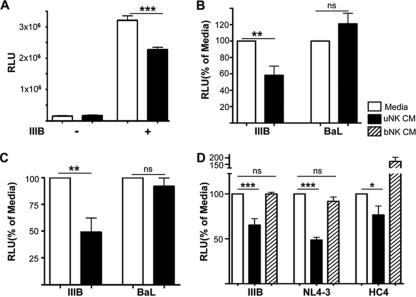FIG. 1.
Human uNK cells produce soluble factors with anti-HIV activity. (A) uNK cells were cultured with or without IL-12 plus IL-15 for 3 days. The resulting cell-free uNK CM was incubated with TZM-bl cells for 1 h and then infected with HIV-1IIIB at an MOI of 1. β-Gal activity was measured after 48 h. Results are means ± SEM of a representative experiment in which each condition was tested in quadruplicate. Media (open bars) and uNK CM (black bars), in the absence (−) or presence of HIV-1IIIB (IIIB), are shown. uNK CM significantly reduced HIV-1 infection in TZM-bl cells. ***, P < 0.001. (B) uNK CM from four different individuals in three different experiments were treated in quadruplicate as in panel A and infected with either HIV-1IIIB or HIV-1BaL (BaL). The data are normalized to RLU from the medium-plus-virus (HIV-1IIIB or HIV-1BaL) conditions and show that the uNK anti-HIV activity is specific for HIV-1IIIB. ***, P < 0.001 (Mann-Whitney test). Values represent means ± SEM (n = 7 different uNK clones). ns, not significant. The y axis shows RLU values, converted into percentages with media as 100%. (C) CM from primary NK cells were treated in quadruplicate as in panel B. Data are representative of two experiments with two different individuals. (D) TZM-bl cells were preincubated for 1 h with tissue culture media (open bars), bNK CM (hatched bars), or uNK CM (black bars). bNK and uNK CM were prepared from the blood and endometrial tissue of the same individual. One hour later, TZM-bl cells were infected with the indicated X4-tropic HIV-1 strains. After 48 h in culture, β-gal activity was measured. Data are expressed as the percentage of β-gal expression relative to the media control. Values represent means ± SEM, with n = 4 different clones. ***, P < 0.001 (one-way analysis of variance).

